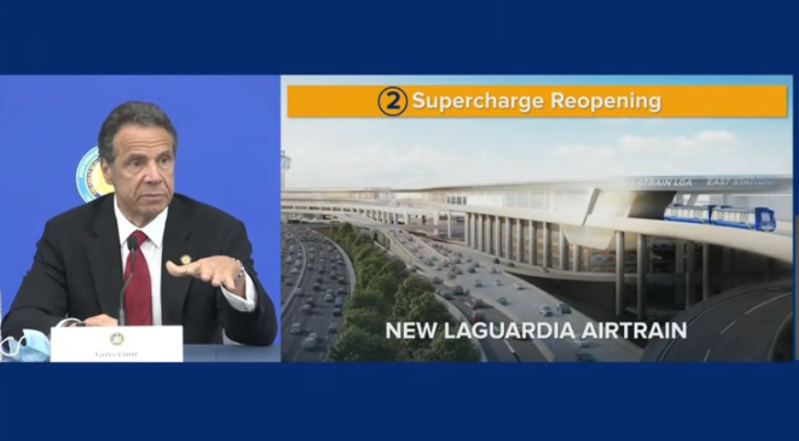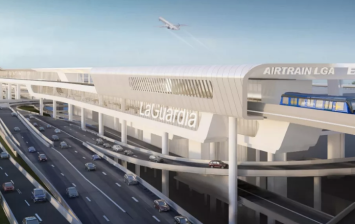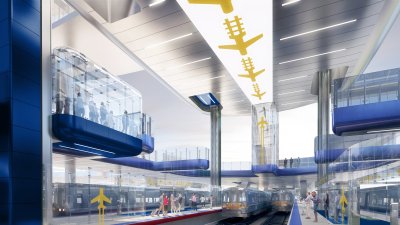Cuomo’s ‘Wrong Way AirTrain’ Boondoggle Moves Ahead
The LaGuardia people-mover gets a shot in the arm — but is it (and the governor) still relevant?

Even as Andrew Cuomo struggles to retain his governorship over mounting allegations of sexual harassment and bullying, his favorite construction boondoggle — the “Wrong-Way” LaGuardia AirTrain — got a shot in the arm Monday as the troubled project attained a key milestone.
The Federal Aviation Administration yesterday published the final Environmental Impact Statement for the proposed $2-billion, 1.5-mile automated people mover, which was first proposed in 2015 and has hit multiple hurdles since — among them, the $3-billion hole that COVID-19 blew in the $20 billion capital plan of the project’s sponsor, the Port Authority of New York and New Jersey.
The publication of the final EIS puts the final nail in the coffin of consideration of alternatives to the AirTrain plan — 47 were considered and rejected — and memorializes the public comments collected on the proposal. After the FAA issues a “Record of Decision” later this spring, AirTrain construction can move forward, “completing the transformation of LaGuardia Airport into a world-class gateway to New York,” per Port Authority literature. Initial utility work and foundations for the automated people mover guideway and stations will commence in June, the document says optimistically.
The Port Authority hailed the EIS as “a very important step forward in building a rapid, reliable, and sustainable rail mass transit link to the airport,” according to a spokeswoman, who trumpeted the idea that it “will create 3,000 construction jobs and $500 million in contracting opportunities for minority and women-owned businesses as well as contracting opportunities for local, Queens-based businesses.”
It’s been a rocky road.
After boasting for years that the AirTrain would not cost taxpayers money for its construction, but would be financed solely by passenger facility fees, a surcharge on tickets, the Port Authority went begging to the feds last May, saying that COVID revenue losses would force “drastic cuts to a variety of critical infrastructure projects.” Cuomo cited the AirTrain as “Exhibit A” in his pleas last year to President Trump to lavish stimulus on New York State, pushing the spending as a way to jumpstart the post-COVID economy.
But two possible snafus might await the project. For one, the political demise of its chief sponsor — Cuomo — might cause it to fade as other priorities (think: the Gateway railway tunnel under the Hudson, a favorite of Sen. Chuck Schumer) gain traction.
“Without a champion mono-manically focused on it, yes, I think there is a possibility that it just recedes,” said Nicole Gelinas, a longtime analyst of infrastructure with the Manhattan Institute, adding, “Schumer cares more about Gateway.”
Also, a little-noticed change in the FAA’s rule on passenger facility fees would allow them to be used to build real rail — and not just dinky people movers — to airports. The change would enable the Port Authority “to modify its current plans for a people mover at LaGuardia and allow the #7 subway or the Long Island Rail Road to go directly to LaGuardia with no transfer” as transit consultant Bob Previdi argued this week in a Streetsblog op-ed. Previdi is pushing the LIRR.
The AirTrain has driven controversy since its inception over its ballooning cost (originally estimated at $500 million), its counter-intuitive route, its relative merits against the possible alternatives, and environmental concerns. It run 1.5 miles between LaGuardia Airport in East Elmhurst and Willets Point, where it would connect to the 7 subway line and the Long Island Rail Road’s Port Washington branch, a spur that does not connect to the Jamaica hub.
Critics complain that its “backwards” route would send travelers further east from LaGuardia — and to a less-useful LIRR line — before they would double back toward the airport (or, during the reverse trip, Manhattan) and wouldn’t save travelers time. Transit analysts say that it adds nothing to the city’s transportation network. Others question the AirTrain’s service assumptions and construction disruptions. The area’s Congress member, Alexandria Ocasio-Cortez, objects to the project.
The EIS, of course, reached the foregone conclusion that the AirTrain is the best alternative for providing rail access to the airport, and that the project jumps through the requisite environmental hoops.

“As with the interim steps along the way, the final EIS simply reinforces the belief that the Port Authority and FAA had their thumbs on the scale at the behest of Cuomo from Day One,” said transit analyst Benjamin Kabak. “Their assessment standards and concerns regarding useful transit extensions have no basis in the reality of planning transit improvements, and it’s as clear now as it was on Day One that a fatally flawed process is supporting a fatally flawed proposal. Improving transit to LaGuardia is a one-in-a-generation opportunity, and the Willets Point AirTrain is a huge miss.”
But will the long-term hit to aviation brought about by the pandemic affect the project’s progress? Air travel has diminished by about two-thirds because of COVID, and industry experts don’t expect passenger volumes to return to pre-pandemic heights until at least 2023 — with business travel, the most profitable part of the industry, taking even longer to recover. The Port Authority’s airports, meanwhile, have experienced an even sharper decline — down 73 percent year over year in January.
The FAA EIS acknowledged the COVID-19-stoked decline in aviation and transit travel “won’t occur until 2024 or later” and that “it is impossible to precisely predict future changes to ridership.” Yet it said that “the need for supplemental access and connections to the region’s existing local transit system” still warranted the project.
Moreover, the Port Authority insists that a combination of fees, ticket revenues and debt will cover the project.
“We have always said projects in construction would move forward,” said the spokeswoman, pointing to the EIS, which states: “The Port Authority funds its capital projects with a combination of proceeds from the issuance of debt and pay-as-you-go capital investment. In addition to an anticipated utilization of [passenger fee] revenues, the Port Authority anticipates utilizing a combination of debt and pay-as-you-go capital derived from AirTrain fares and capital and operating cost recovery revenues from the airlines together with other Port Authority net revenues.”
Previdi, for one, is sanguine about the need for a rail connection to LaGuardia “no matter what,” because “capital cuts may come, but the need for rail access at LGA is still there.” He says that the route that has been approved — the Willets Point route along Flushing Bay and the Grand Central — is the “most valuable,” because it would enable the LIRR’s Port Washington Branch, which has spare capacity, to run directly to the airport.
“Using the LIRR could become a part of a longer-term regional transport strategy to provide access beyond the city to include regional destinations (something the Regional Plan Association has promoted for many years),” he wrote in his op-ed.


